
www.efoodcard.com
Food Industry Training
Food Handler Basic Course Study Guide

eFoodcard.com / Copyright © 2019 ii
Table of Contents
Why Read This Manual? .......................................1
Food Handler Card .........................................................1
Training Required ............................................................1
Reciprocity and Equivalency ......................................1
How to Use This Manual ...............................................1
A “Person in Charge” is Required .............................1
Chapter 1. Food Handler Training
Learning Objectives ............................................. 3
1.1 Employee Illness ..................................................3
1.2 Hand-Washing ......................................................3
1.3 No Bare Hand Contact with
Ready to Eat Food ............................................. 4
1.4 Your Role in Helping Prevent
Foodborne Illness ................................................5
1.5 The Role of Management in Helping
Prevent Foodborne Illness .............................. 6
1.6 Foodborne Illness ............................................... 6
1.7 Temperature Control ..........................................7
1.8 Final Cooking Temperature .............................7
1.9 Contamination and
Cross Contamination ........................................ 8
1.10 Work Only When You Are Well ..................... 9
Chapter 1 Review ..........................................................10
Chapter 2. Prevent the Spread of Disease ....... 11
2.1 Why Hand Washing is Very Important ...... 11
2.2 Germs are Everywhere ..................................... 11
2.3 No Bare Hand Contact .................................... 12
2.4 Ready-To-Eat ...................................................... 12
2.5 Gloves and Hand-Washing ............................ 12
Chapter 2 Review ......................................................... 13
Chapter 3. Employee Practices......................... 14
3.1 Take Care of How You Look
and How You Act...............................................14
3.2 Fingernails ............................................................14
3.3 Gloves Can Spread Germs ............................ 14
3.4 Beverages .............................................................14
Chapter 4. What Makes People Sick
from Food? .......................................................... 15
4.1 Foodborne Illness .............................................. 15
4.2 Time/Temperature Control for
Safety/Potentially Hazardous Foods ......... 15
4.3 Bacteria ................................................................. 15
4.4 Viruses ................................................................... 16
4.5 Parasites ................................................................16
4.6 Chemicals ............................................................. 16
4.7 Physical Contamination ..................................16
4.8 Contaminated Food .........................................16
Chapter 5. Food Temperatures ......................... 17
5.1 Temperature Control (for Food Safety) ... 17
5.2 The “Danger Zone” ...........................................17
5.3 When to Discard Food .................................... 17
5.4 Cooking Food ..................................................... 17
5.5 When is Cooked Food Safe? ......................... 18
5.6 Remember ...........................................................18
5.7 Cold Holding .......................................................18
5.8 Hot Holding .........................................................18
5.9 Keep it Hot ..........................................................18
5.10 Keep it Cold .........................................................18
Chapter 5 Review .........................................................19
Chapter 6. Safe Storage Practices .................. 20
6.1 Cross Contamination ......................................20
6.2 Keep Foods Safe from Contamination.....20
Chapter 7. A Clean Workplace is Safer............ 21
7.1 Follow These Important Rules ..................... 21
7.2 Utensils, Surfaces and Equipment .............. 21
7.3 Directions ............................................................ 22
7.4 Remember .......................................................... 22
Chapter 7 Review ........................................................ 23
Glossary ...............................................................24
Reference ............................................................. 25
General ............................................................................ 25
Employee Illness .......................................................... 26
Most Common Illnesses from Employees .......... 26
Hand-Washing .............................................................. 27
Cooking Temperatures .............................................. 28
“Is It Done Yet?” ........................................................... 30
Calibrating a Dial Food Thermometer ................ 32
Cooling Hot Foods .....................................................33
Date Marking ...............................................................36
Pests ................................................................................. 36

eFoodcard.com / Copyright © 2019 1
Food Handler Card
All food handlers employed in food
service must obtain a food handler
card within 30 days from the date of
hire. As a food handler, you are required
to keep your food handler card current
by renewing it every three years or
as required.
Training Required
The goal of this program is to provide
you with a basic understanding of food
safety. This will assist your manager,
who is responsible for ensuring that
you prepare and serve food safely.
A food handler card confirms that
you have met the learning objectives
for this certificate course.
Reciprocity and
Equivalency
Any person who has a current
certificate from a department-
approved food manager certification
program need not obtain a food
handler card.
To be accepted in place of a food
handler card, a food manager
certificate must be current and
renewed upon expiration.
Photocopies of the food handler cards
and food manager training certificates
should be kept at the facility to show
the health inspector upon request.
How to Use This Manual
This manual is intended to help you
learn what you need to know to obtain
a food handler card. You will need a
score of 70% to pass. You will be tested
on all of the learning objectives that are
listed on pages (3-9). Throughout this
manual you will find study questions
that will help you get ready to take the
test for the food handler card.
The words that are italicized and bold
are explained in the glossary located in
the back of this manual.
A “Person in Charge”
is Required
Someone at your restaurant must be
in charge during all hours of operation.
This person in charge (PIC) is responsible
for knowing the food sanitation rules and
the procedures within your establishment.
This person is responsible for providing
you with information you need to perform
your job.
The PIC is usually a manager or
supervisor, but can be anyone who can
demonstrate the knowledge listed above,
and is given the authority to oversee
other employees.
Why Read This Manual?

Download and save
this booklet as a reference.

eFoodcard.com / Copyright © 2019 3
Chapter 1. Food Handler Training
Learning Objectives
Food workers are expected to know this information to obtain their food handler card.
The concept of foodborne illness will be introduced. The training will address
personal hygiene, contamination, and temperature control to reinforce the food
handler’s behaviors, which can prevent foodborne illness.
Section 1.1 Employee Illness
• The food handler will know to call the person in charge at the food service
facility when ill with diarrhea, vomiting, jaundice, or fever with sore throat.
• The food handler will know not to work in the food service facility while
ill with these symptoms.
• The food handler will know to not work in food service for 24 hours after
symptoms of diarrhea or vomiting have gone.
• The food handler will know not to handle food with an infected boil, cut,
burn, or sore on the hand or wrist. Food may be handled if the injury is
covered with a clean bandage and a latex-free glove.
Section 1.2 Hand-Washing
Workers will understand elements of good hand-washing.
• The food handler will be able to
identify the correct technique
for hand-washing:
• Use running warm water and soap
• Scrub hands and rinse thoroughly
(approximately 20 seconds)
• Dry hands with single-use towel,
or air dryer
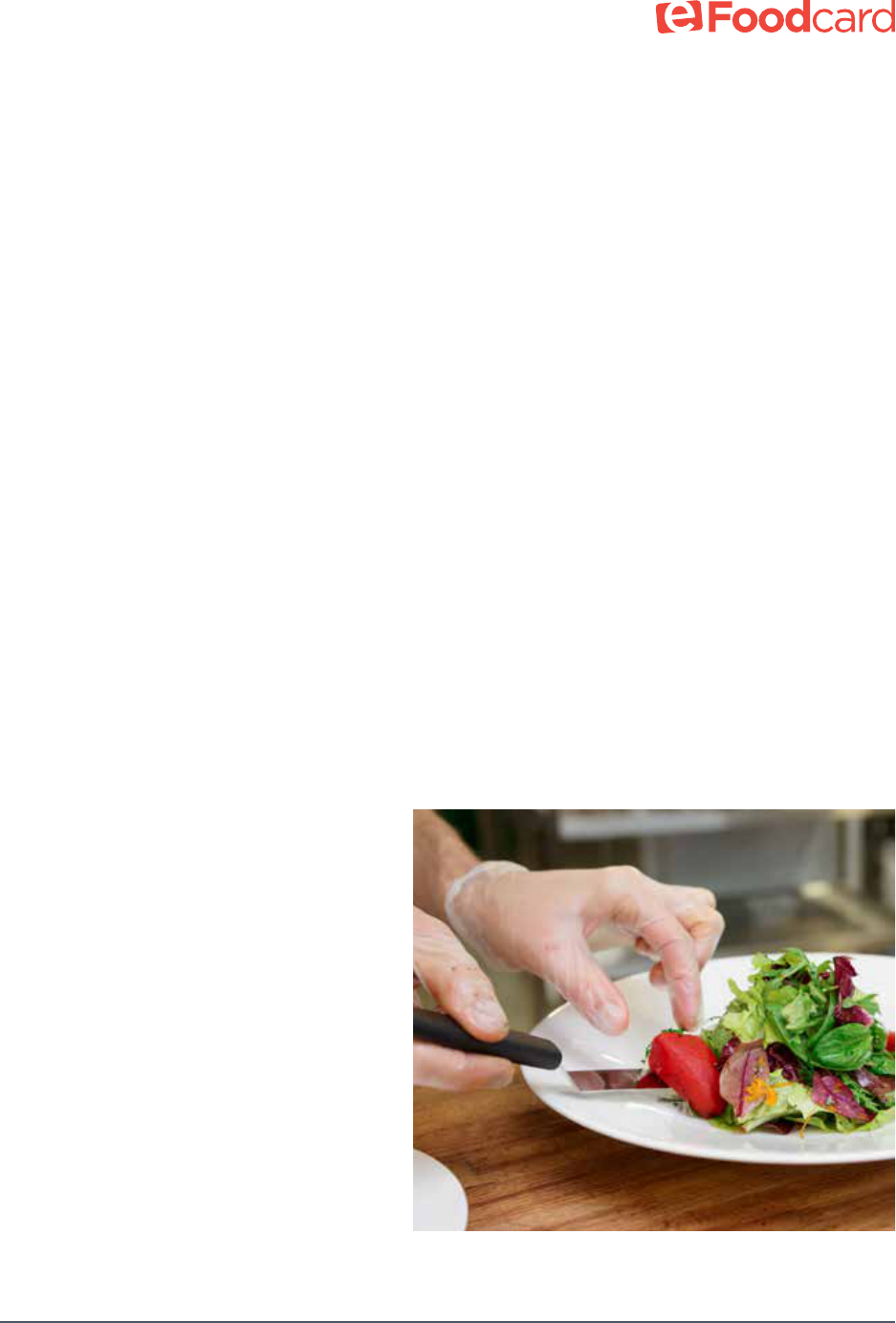
eFoodcard.com / Copyright © 2019 4
• The food handler will be able to identify situations when food handlers
must wash their hands:
• Before starting work
• After using the toilet and again when entering work area
• After handling raw food and raw animal products
• After handling dirty dishes
• After handling garbage
• After cleaning or using chemicals
• After blowing nose, sneezing, coughing, or touching eyes,
nose or mouth
• After smoking, or using tobacco products
• After eating or drinking
• Before putting on food service gloves
• The employee food handler will know that the food service gloves can
spread germs and is not a substitute for proper hand washing.
• The food handler will know that smoking, eating, and chewing tobacco is
prohibited in food preparation areas, including food and utensil storage areas.
Section 1.3 No Bare Hand Contact with Ready to Eat Food
• The food handler will know
that touching ready-to-eat
foods with bare hands is not
allowed. A food worker must
use utensils or single use
gloves when working with
ready-to-eat food. Good hand
washing is still required even
when using utensils or gloves
to handle food.
• The food handler will know
that food service gloves are
capable of spreading germs
and are not a substitute for
proper hand-washing.

eFoodcard.com / Copyright © 2019 5
• The food handler will be able to identify situations when gloves must be
discarded; hands washed and new gloves are worn:
• As soon as gloves become soiled or torn
• Before beginning a dierent task
• After handling raw meat, fish, or poultry
• Before handling ready-to-eat food.
• The food handler will be able to identify ready-to-eat food as foods that are
edible without washing, cooking, or additional preparation. These foods include:
• Raw, washed and cut fruits and vegetables; and
• Food that require no additional cooking
• The food handler will know they may prevent bare-hand contact by using:
• Deli tissue
• Spatulas/Tongs/Forks/Utensils
• Dispensing equipment
• Single-use gloves
Section 1.4 Your Role in Helping Prevent Foodborne Illness
• The food handler will be able to describe five major mistakes that
often cause foodborne illness:
1. Inadequate hand-washing
2. Employees working while they are ill
3. Cross contamination
4. Inadequate cooking temperatures
5. Inadequate temperature control
(allowing foods to be in the danger zone)

eFoodcard.com / Copyright © 2019 6
• The food handler will be able to describe the activities performed
by food handlers that prevent foodborne illness from happening.
Activities preventing foodborne illness include:
• Proper hand-washing every time hands may have become contaminated
• Food handlers working only when healthy
• Storing and handling of foods in a manner to prevent contamination
• Cooking each animal product to its required internal temperature
• Maintaining hot and cold temperatures
(keeping foods out of the danger zone)
• Use of utensils or single-use gloves to prevent bare hand contact
with ready-to-eat food.
Section 1.5 The Role of Management in Helping
Prevent Foodborne Illness
• The food handler will know that the manager sets the tone of what food
safety activities occur or don’t occur within the facility.
• The food handler will know that the food service management is
responsible for training and ensuring that food handlers practice activities
that prevent foodborne illness.
Section 1.6 Foodborne Illness
• The food handler will be able to describe foodborne illness as an illness
resulting from eating contaminated food.
• The food handler will know that food contaminated with organisms (germs)
does not always look, smell or taste dierent from non-contaminated food.
• The food handler will know that symptoms vary and may include diarrhea,
vomiting, fever, cramping and nausea.
• The food handler will know that depending on the cause, symptoms may
develop in a few minutes to several days. Some symptoms may last several
days and can result in death.
• The food handler will know that foodborne illness is caused by organisms
(germs), chemicals, or toxins.
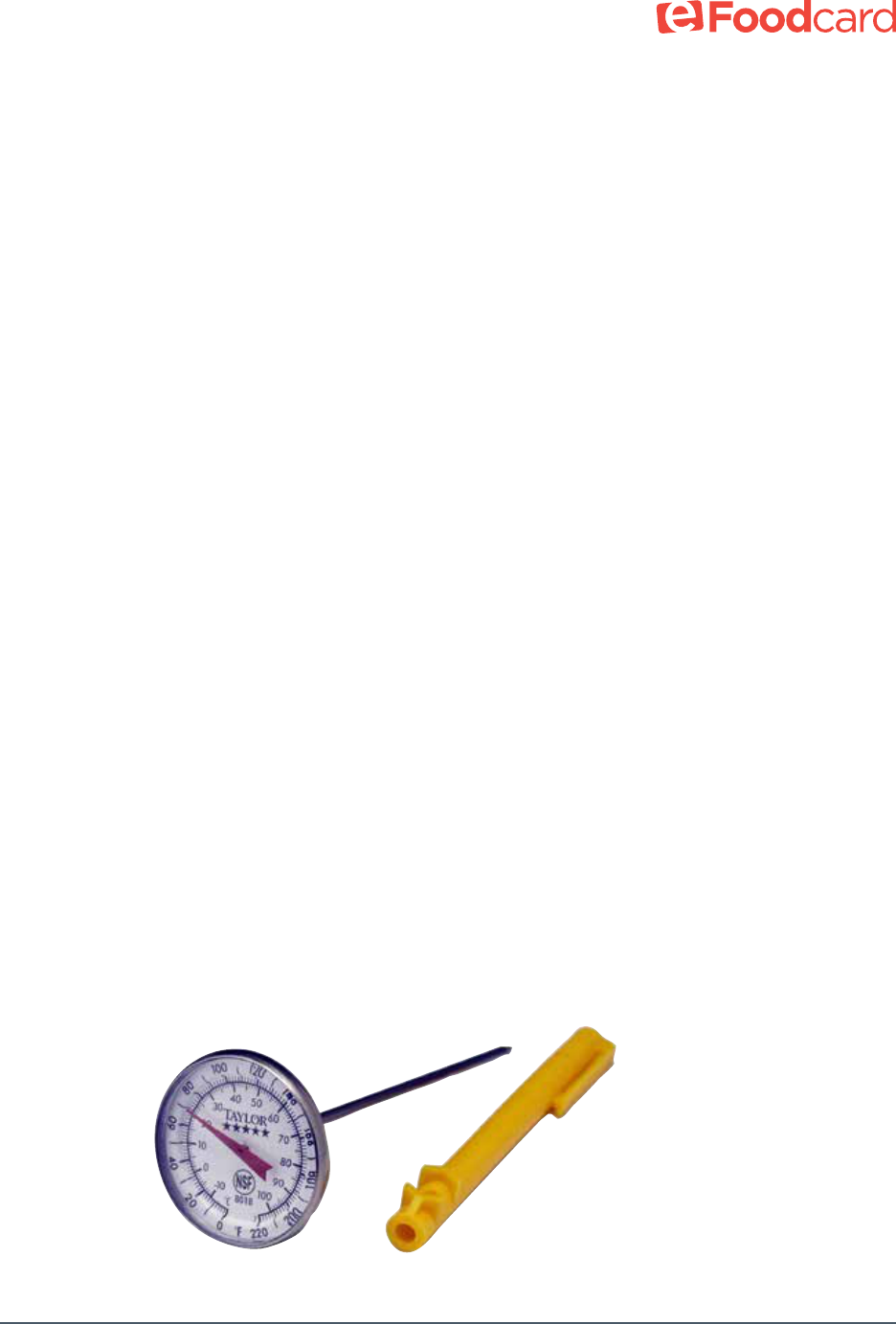
eFoodcard.com / Copyright © 2019 7
Section 1.7 Temperature Control
Workers will understand why hot and cold holding temperatures are
important factors in preventing illness.
• The food handler will be able to identify time/temperature control for
safety/potentially hazardous foods as food that will support bacteria
growth when held at temperatures in the danger zone.
• The food handler will be able to identify the danger zone as any
temperature between 41°F and 135°F.
• The food handler will be able to identify that food being cooled or heated
must move through the danger zone as rapidly as possible.
• The food handler will be able to identify 135°F or hotter as the proper
temperature for hot holding time/temperature control for safety/
potentially hazardous foods.
• The food handler will be able to identify 41°F or colder as the proper
temperature for cold holding time/temperature control for safety/
potentially hazardous foods.
• The food handler will know that you cannot make food safe to eat when
food has been in the danger zone for four hours or more.
Section 1.8 Final Cooking Temperature
Workers will understand why cooking foods to proper temperatures are
important for preventing illness.
The food handler will be able to identify that cooking foods to the
recommended temperature will kill disease-causing germs.
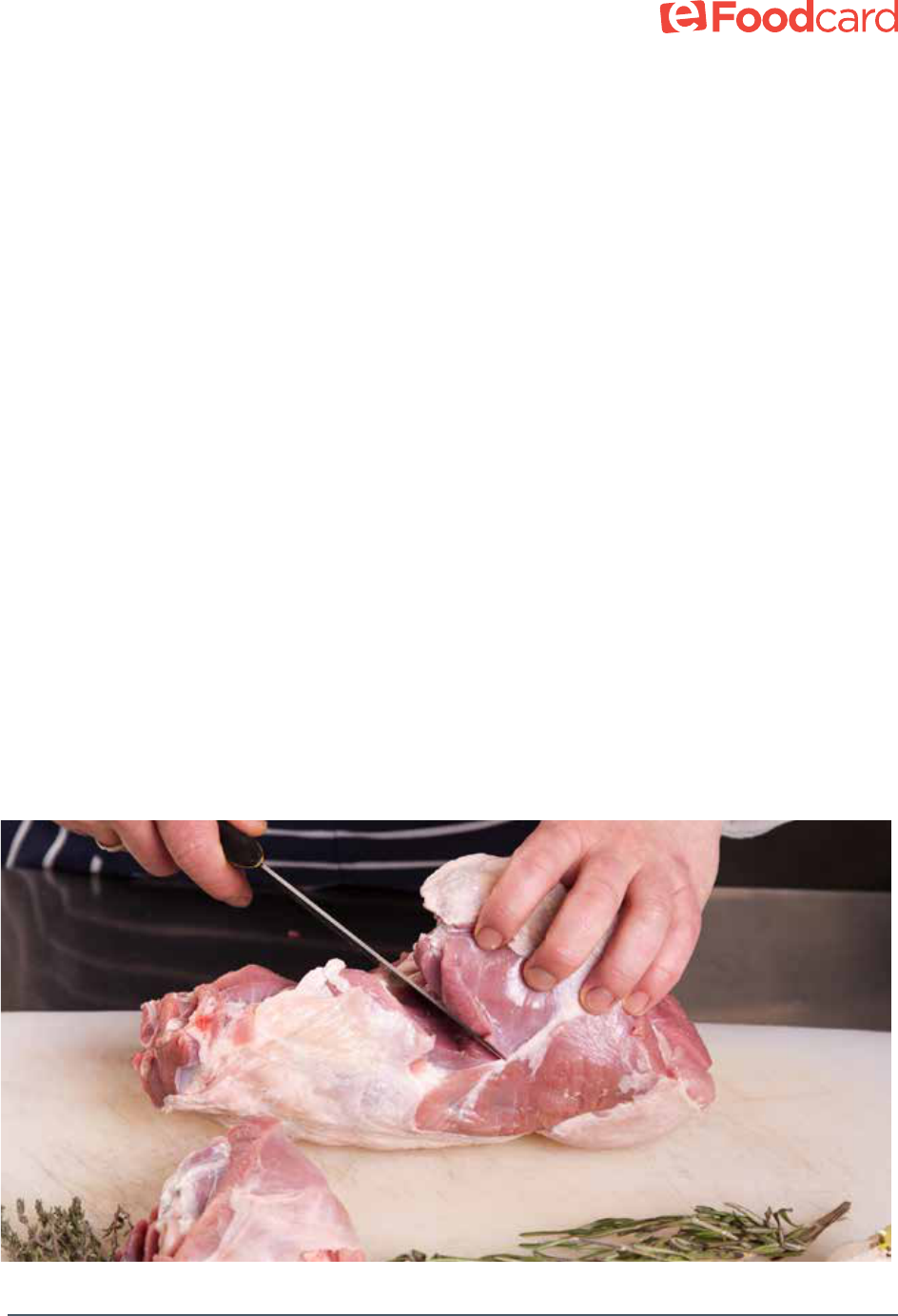
eFoodcard.com / Copyright © 2019 8
Section 1.9 Contamination and Cross Contamination
Workers will understand why cross contamination is dangerous and
know ways to prevent it.
• The food handler will be able to define and identify physical contamination
as foreign objects accidentally introduced into food. Food items may arrive
already contaminated with dirt and pebbles.
• The food handler will be able to define and identify cross contamination as
happening when microorganisms are transferred from one food or surface
to another food.
• The food handler will be able to identify methods to prevent cross
contamination such as washing, rinsing, and sanitizing utensils, work
surfaces and equipment between uses.
• The food handler will be able to identify storage conditions that will
minimize the potential for cross contamination:
• Store raw meats below and completely separate from ready-to-eat food
in refrigeration units
• Store chemicals, cleansers and pesticides completely separate from
food, utensils, and single service items
• Properly label all chemicals, cleansers and pesticides

eFoodcard.com / Copyright © 2019 9
Section 1.10 Work Only When You Are Well
If you feel sick you should not go to work. The germs you bring to work can
spread when you touch food, dishes, counters, utensils, and other people.
• Do not work if you have a fever and sore throat
• Do not work if you have loose bowels (diarrhea)
• Do not work if you are throwing up (vomiting)
• Do not work if you have yellowing of the skin or dark tea colored
urine (jaundice)
• Wait for at least 24 hours after vomiting or diarrhea have stopped
before returning to work.
Tell your manager if you have any of
these symptoms. If the manager has
questions, he or she can call the County
Health Department.
Do not handle food with an infected
boil, burn, cut or sore on your hand.
Food may be handled if you cover the
injury with a clean bandage, and wear
a latex-free glove.
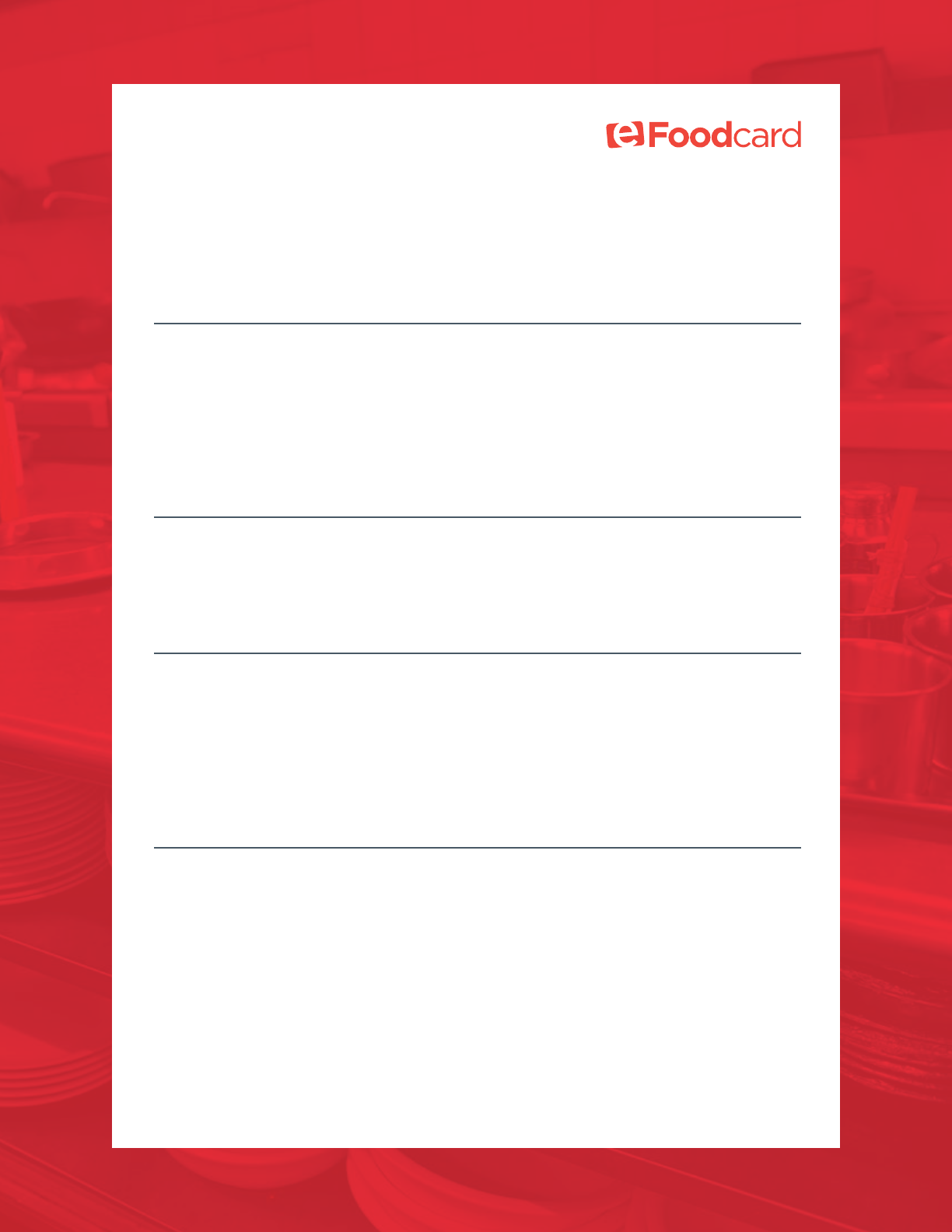
eFoodcard.com / Copyright © 2019 10
Here are some questions to help you review the material.
1. When you have a sore throat with fever or diarrhea, you should:
A. Go to work and tell your coworkers to be careful around you
B. Call your manager and report that you are sick
C. Take medicine to stop the symptoms and go to work
D. Not tell anyone and continue working
2. If you are ill, tell your manager before starting work.
A. True
B. Fasle
3. Food handlers can contaminate food when they:
A. Discard food left in the danger zone
B. Take a break in a designated area
C. Keep chemicals away from food
D. Have infected wounds or injuries
4. Food handlers can contaminate food when they:
A. Keep fingernails short for easy cleaning underneath
B. Change gloves for fresh gloves between tasks
C. Have been diagnosed with a foodborne illness
D. Drink from a closed beverage cup with lid and straw
Chapter 1 Review

eFoodcard.com / Copyright © 2019 11
Section 2.1 Why Hand
Washing is Very Important
Wash your hands often when working
with food and drinks – this gets rid
of germs that can make people sick.
Wash your hands for approximately
20 seconds with warm running water
and soap, and then dry them with
clean paper towels, or an air dryer.
Remember to always wash your hands:
• Before you start preparing food
• After using the toilet and again when entering work area
• After handling raw animal products
• After handling dirty dishes and garbage
• After cleaning or using chemicals
• After blowing nose, sneezing, coughing, or touching eyes, nose or mouth
• After smoking or using tobacco products
• After eating or drinking
• Before you put on latex-free gloves
Section 2.2 Germs are Everywhere
Germs such as bacteria and viruses are everywhere. If you do not wash your
hands in the right way and use a barrier between your hands and ready-to-eat
food, your hands can put germs in food that will be eaten by your customers.
Your customers may get sick from these germs.
Chapter 2. Prevent the Spread
of Disease

eFoodcard.com / Copyright © 2019 12
Section 2.3 No Bare Hand Contact
Bare hand contact with ready-to-eat food is not allowed. Ready-to-eat foods
are edible without washing, cooking or additional preparation before service.
Section 2.4 Ready-To-Eat
These foods include:
• Raw, washed and cut fruits and vegetables
• Food that require no additional cooking, such as sandwiches
and salads
Instead of bare hands, you can use:
• Utensils, tongs, forks
• Deli tissue
• Dispensing equipment or
• Non-latex, single-use gloves
Section 2.5 Gloves and Hand-Washing
Gloves and other barriers do not replace hand-washing. Wash hands
before putting gloves on and when changing to a new pair.
Change your gloves:
• As soon as they become soiled or torn
• Before beginning a dierent task
• After handling raw meats, fish, or poultry and
• Before handling ready-to-eat food
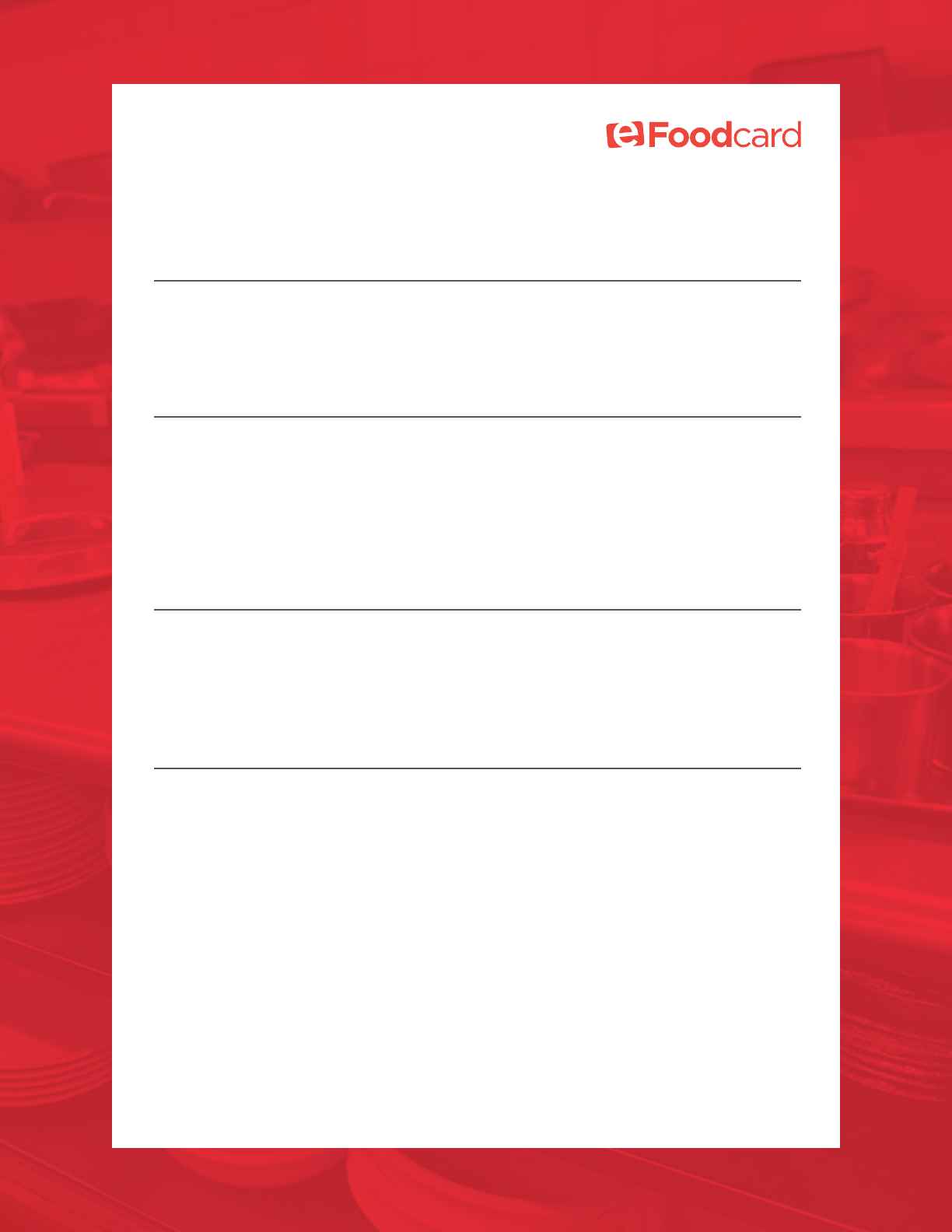
eFoodcard.com / Copyright © 2019 13
Chapter 2 Review
1. You must wash your hands between changing gloves.
A. True
B. False
2. When must you wash your hands?
A. After sneezing or coughing
B. After touching raw meat
C. After eating or drinking
D. All of the above
3. No bare hand contact is required when foods requiring no
additional cooking are served.
A. True
B. False
4. When must you change single-use gloves?
A. Every hour
B. At the beginning of the shift
C. Before handling ready-to-eat food
D. Before handling raw meats

eFoodcard.com / Copyright © 2019 14
Section 3.1 Take Care of How You Look and How You Act
Do not smoke or chew tobacco while you are working or when you are near
food or dishwashing areas. Smoke only while you are on a break. After you
smoke, wash your hands before you return to work.
Section 3.2 Fingernails
Be sure to scrub underneath your fingernails. It is much easier to keep
fingernails clean when they are kept short.
Section 3.3 Gloves Can Spread Germs
Single-use food service gloves can also spread germs. Always wash and dry
your hands before putting on gloves. Wash again when gloves are removed.
Change gloves between tasks. When you wear gloves be aware that gloves
can spread germs onto food that will not be cooked. Even when you wear
gloves, it is best to keep fingernails short.
Section 3.4 Beverages
When you are thirsty while working, you
may drink from a closed beverage cup
with lid and straw or cup with lid and
handle. This is allowed only if
the food worker is careful to prevent
contamination of hands, equipment,
any service items, and exposed food.
Chapter 3. Employee Practices
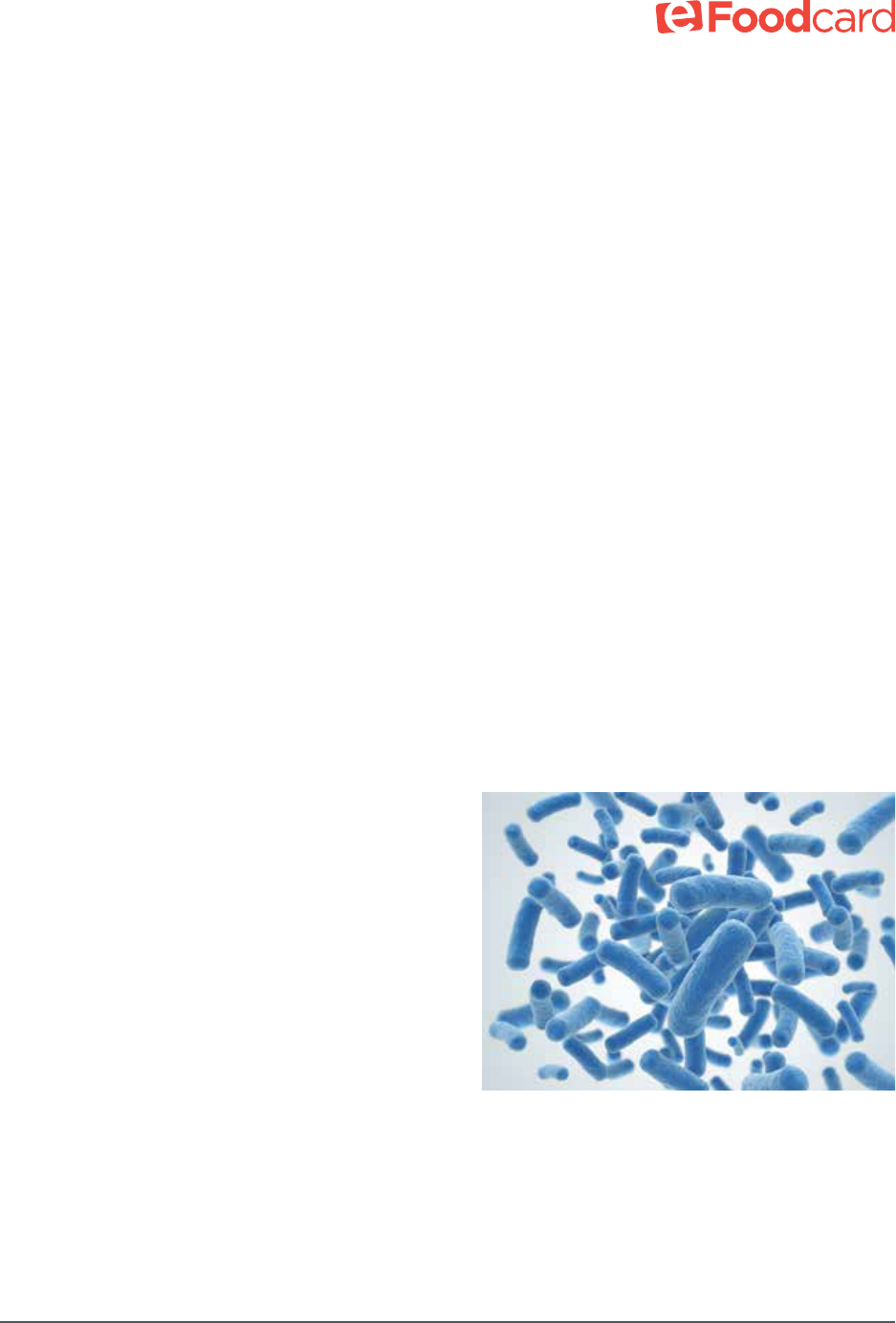
eFoodcard.com / Copyright © 2019 15
Section 4.1 Foodborne Illness
People can get sick when the food they eat has germs. Germs cause
foodborne illness or food poisoning.
Section 4.2 Time/Temperature Control for
Safety/Potentially Hazardous Foods
Germs grow easily in foods like meat, fish, poultry, milk, re-fried beans,
cooked rice, baked potatoes and cooked vegetables. These are called time/
temperature control for safety/potentially hazardous foods. These are all foods
that are moist and they have nutrients that the germs need to grow. Germs
grow well on these foods at warm temperatures between 41°F and 135°F.
Section 4.3 Bacteria
Dierent kinds of germs can make
people sick. Bacteria are one kind of
germ. They grow fast and they may
cause foodborne illness. Some bacteria
make toxins that act like a poison.
Cooking does not destroy most toxins.
Almost always, the food looks and smells
good, but it may have enough bacteria
or toxin to make someone sick. Toxins
can occur in many foods that have not
been kept cold enough or hot enough.
Chapter 4. What Makes People
Sick from Food?
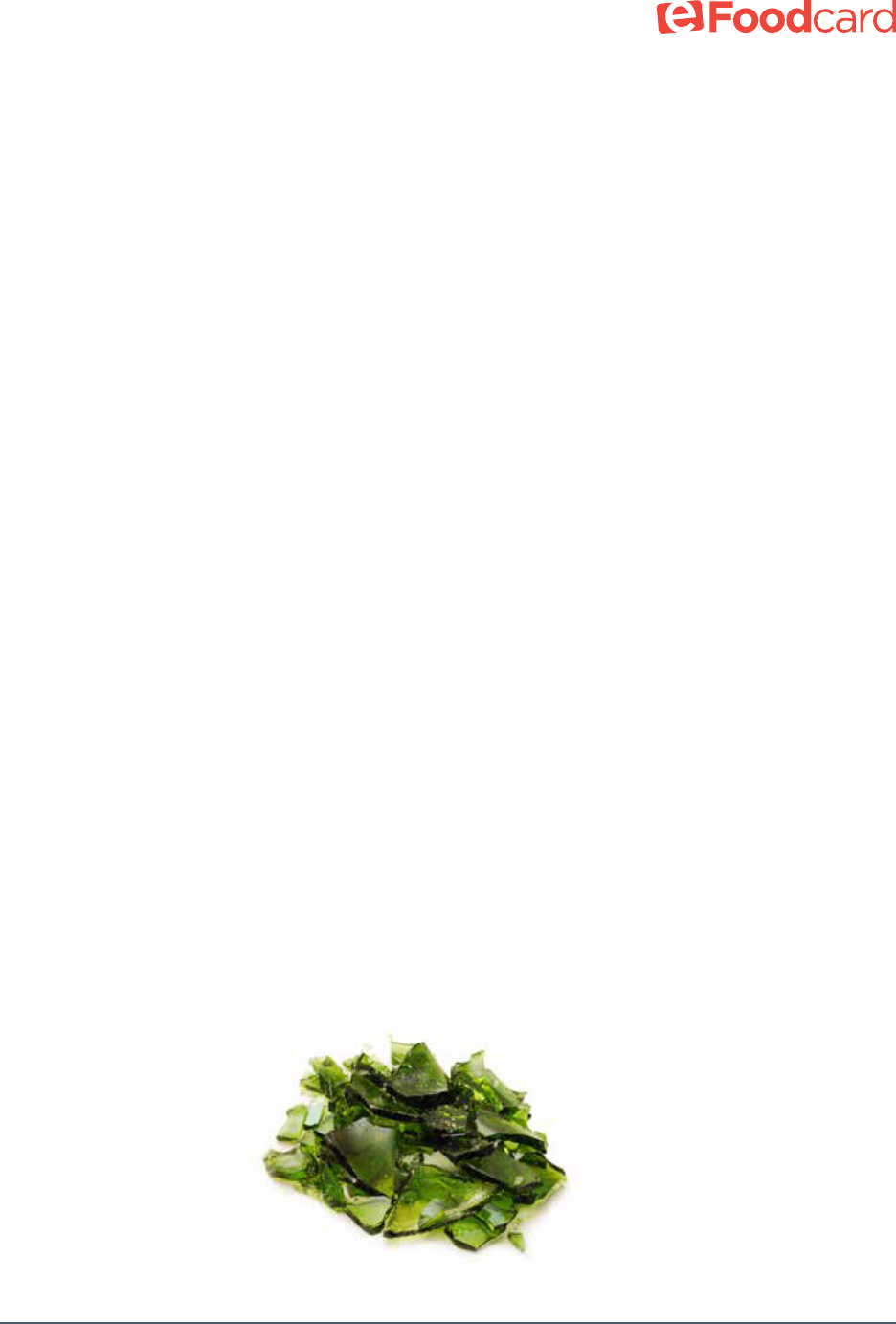
eFoodcard.com / Copyright © 2019 16
Section 4.4 Viruses
A virus is another kind of germ that causes illness when it gets into the food.
You can have a virus and not know it. Even before you start feeling sick,
you may be passing viruses into the food by not washing your hands after
coughing, sneezing or using the toilet. This is one reason why hand-washing
and not touching ready-to-eat foods with your bare hands is so important.
Two examples of these are the hepatitis A and norovirus.
Section 4.5 Parasites
Tiny worms that live in fish and meat are called parasites. Cooking fish and
meat to the right temperature will kill parasites.
Section 4.6 Chemicals
People can also get sick when chemicals get into the food. Be sure to keep
chemicals away from food.
Section 4.7 Physical Contamination
Physical contamination is when foreign objects are accidentally introduced
into food. Food items may arrive already contaminated with dirt, and pebbles.
Physical contamination such as broken glass can also happen at the facility.
Section 4.8 Contaminated Food
The food is contaminated. Now what? Discard contaminated food, and notify
your manager right away!
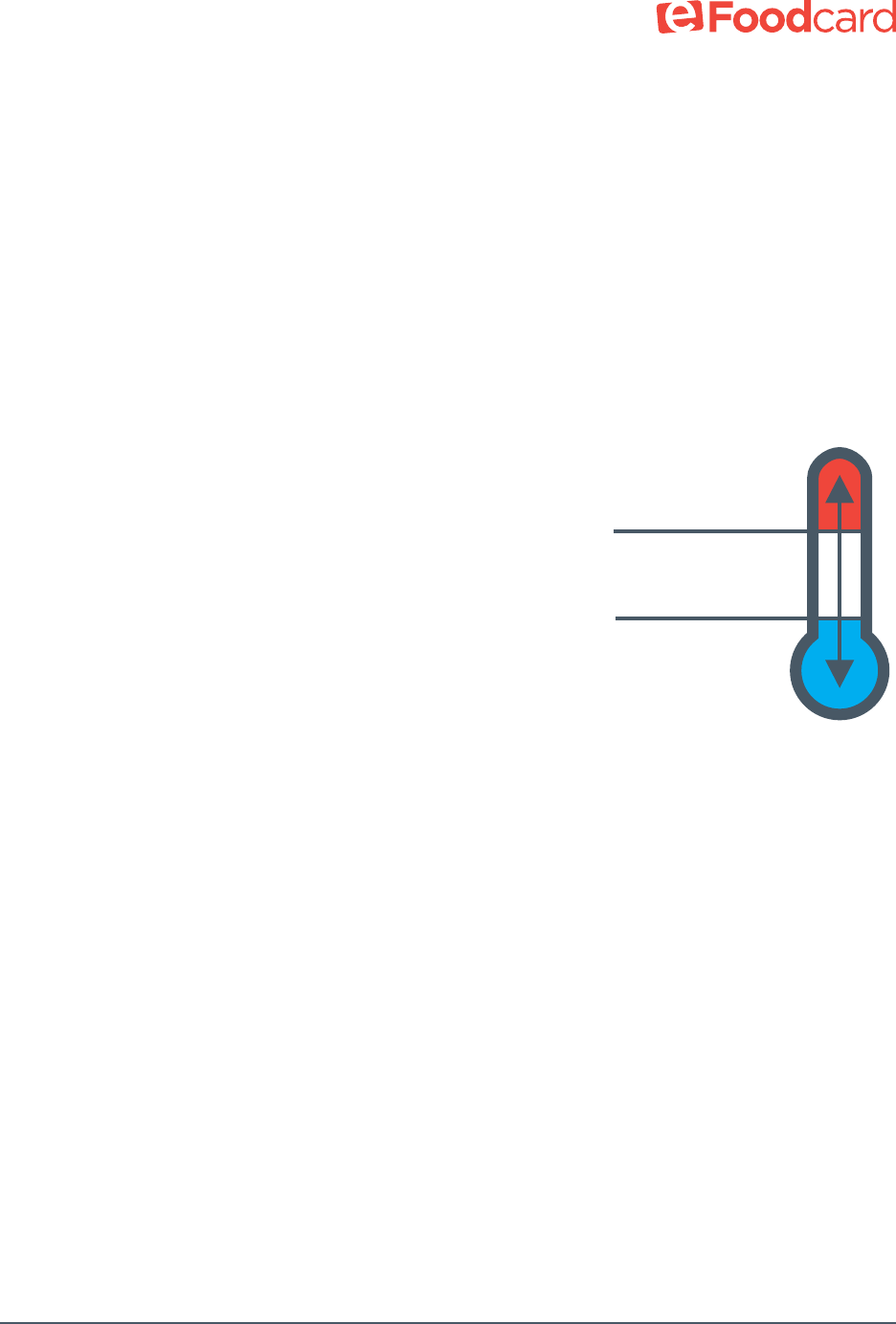
eFoodcard.com / Copyright © 2019 17
Section 5.1 Temperature Control (for Food Safety)
This section is about killing germs with cooking and stopping their growth
by keeping the food hot or cold. This is called temperature control, and your
restaurant needs at least one accurate metal-stem probe (food) thermometer
to check food temperatures.
Section 5.2 The “Danger Zone”
Germs like
bacteria
need time, food and moisture
to grow. The temperature between 41°F (5°C)
and 135°F (57°C) is called the “Danger Zone!”
When food sits in the “Danger Zone”,
bacteria
can grow fast and make toxins that can make you
and others sick.
Section 5.3 When to Discard Food
Foods left in the Danger Zone for more than four hours must be discarded.
Reheating the food may kill the
bacteria
but the toxins (produced by
bacteria
)
will remain in the product and cause illness.
Section 5.4 Cooking Food
Cooking raw food to the proper temperature will kill germs that cause people
to become sick.
Chapter 5. Food Temperatures
135°F (57°C)
“Danger Zone”
41°F (5°C)
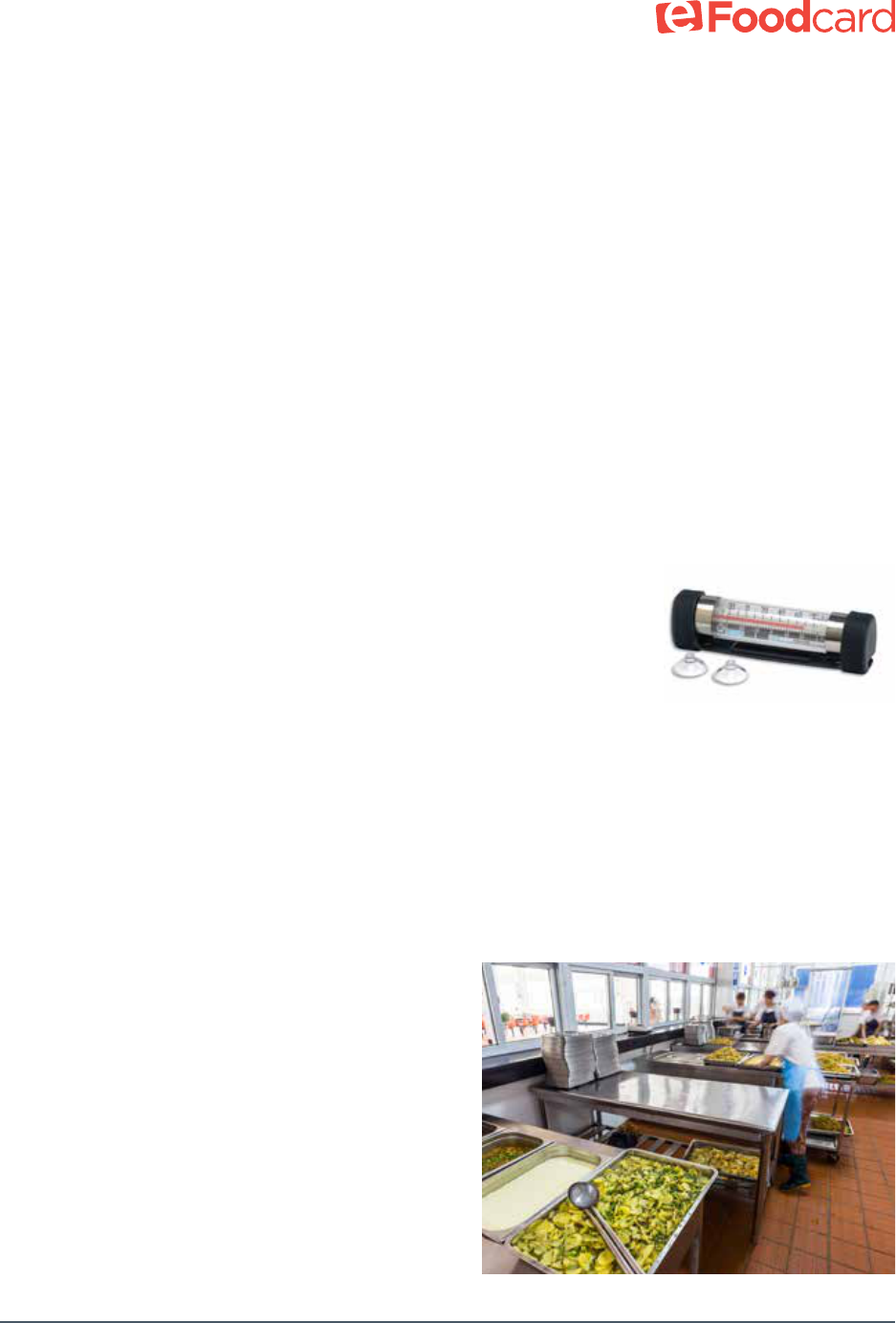
eFoodcard.com / Copyright © 2019 18
Section 5.5 When is Cooked Food Safe?
Dierent foods have to reach dierent temperatures to be done or safe.
Ask your manager to show you a temperature chart for cooking meats
(see page 32). Be sure to cook the food to the temperature that is shown
on the chart.
Section 5.6 Remember
You can choose several ways to cook food. No matter how you cook the
food, it must reach the correct cooking temperature. Using a metal-stem
probe thermometer is the only way to know the correct temperature of food.
You must place the thermometer in the thickest part of the meat or in the
center to get a true reading.
Section 5.7 Cold Holding
Always keep cold food at 41°F (5°C) or colder.
Fish, shellfish, poultry, milk and red meat will stay fresh
longer if you hold them cold at 41°F (5°C) or colder.
Section 5.8 Hot Holding
After the food is cooked and ready to serve, you will need to keep it warm
enough to stop any germs from growing. You must turn on steam tables, soup
warmers and heated surfaces before you need them so that they will be hot
enough when you put the cooked food into them. Keep hot food at 135°F
(57°C) or hotter.
Section 5.9 Keep it Hot
Stir food to help keep the food on top
hot. A cover on the pan helps to keep
the heat inside.
Section 5.10 Keep it Cold
Food being held cold on the top
section of a refrigerated preparation
unit also benefits from being covered.
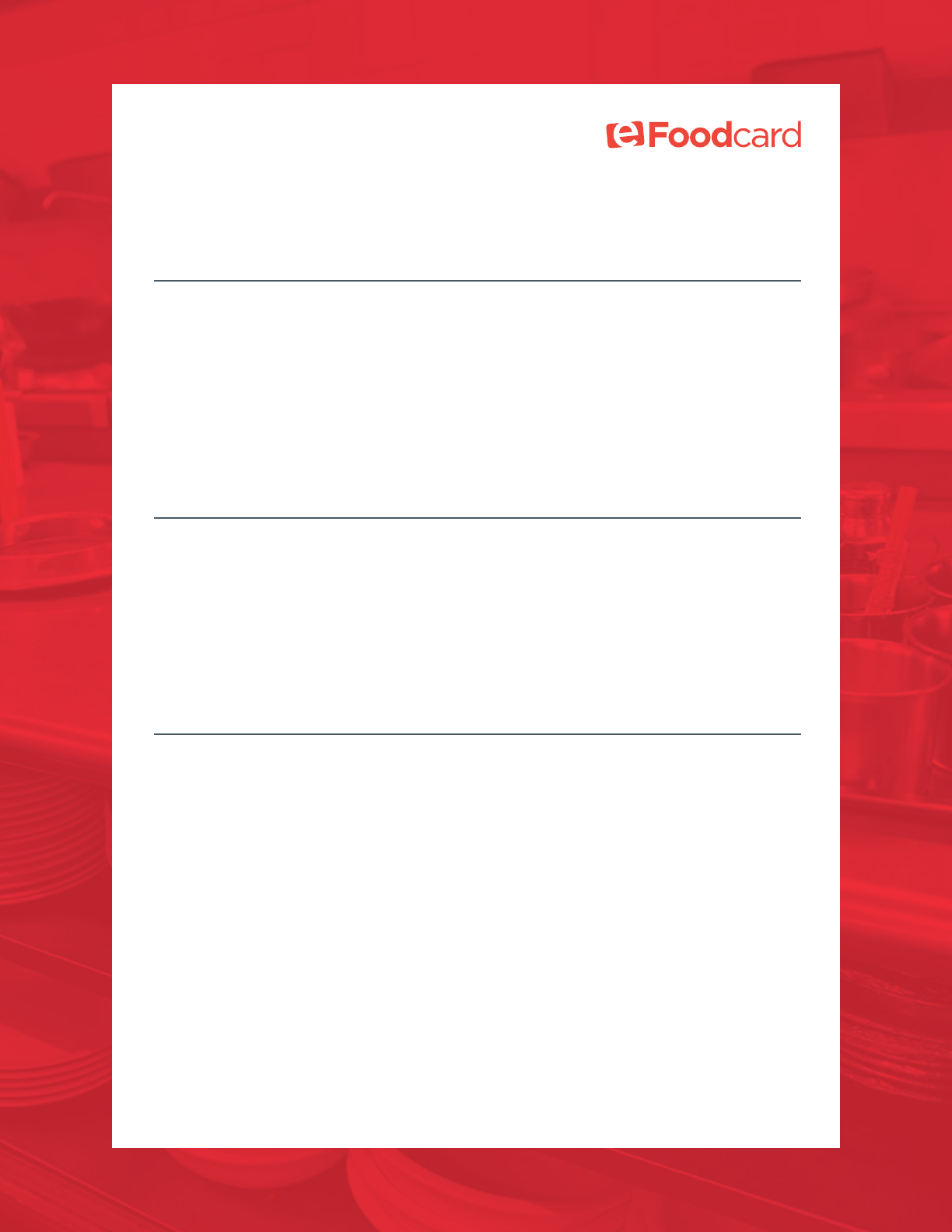
eFoodcard.com / Copyright © 2019 19
1. What is it called when someone gets sick from eating
food contaminated with germs or toxins?
A. Time/temperature control for safety/potentially
hazardous foods
B. Ptomaine poisoning
C. Foodborne illness
D. Raw food
2. How hot must food be kept at on the steam table to
keep food safe?
A. Hot – 120°F
B. Hot – 130°F
C. Hot – 135°F
D. Hot – 165°F
3. How cold does a salad bar or refrigerator have to be to
keep food safe?
A. Cold - 41°F
B. Cold – 65°F
C. Cold - 51°F
D. Cold - 55°F
Chapter 5 Review

eFoodcard.com / Copyright © 2019 20
Chapter 6. Safe Storage Practices
You want all the food you use to be healthy and safe. This section talks
about how to safely store and handle food.
Section 6.1 Cross Contamination
Cross contamination happens when germs from raw or unclean food get
into foods that are ready to serve or that will not be cooked again before
you serve them.
Section 6.2 Keep Foods Safe from Contamination
As a food handler you must prevent cross contamination. Here are some
important ways that you can prevent cross contamination.
• Store raw meat, fish, and poultry on the lower shelves of the refrigerator.
• Don’t let raw meats; beef, pork, lamb, fish or poultry drip onto foods that
will not be cooked before serving.
• Keep dierent types of raw meat separate from each other.
• Store unwashed food or raw food away from ready-to-eat food.
• Wash your hands between handling raw meat and foods that will not be
cooked before eating.
• Never store foods that will not be cooked before serving in the same
container as raw meat, fish or poultry.
• Wash your hands before working with food and before wearing gloves.
• Use utensils or disposable gloves to work with ready-to-eat food.
• Wash, rinse and sanitize the cutting surface and all the utensils and knives
every time you finish with a job or between preparing dierent foods.
• Use clean utensils instead of hands for dispensing food.
• Store foods away from cleaners and poisons.
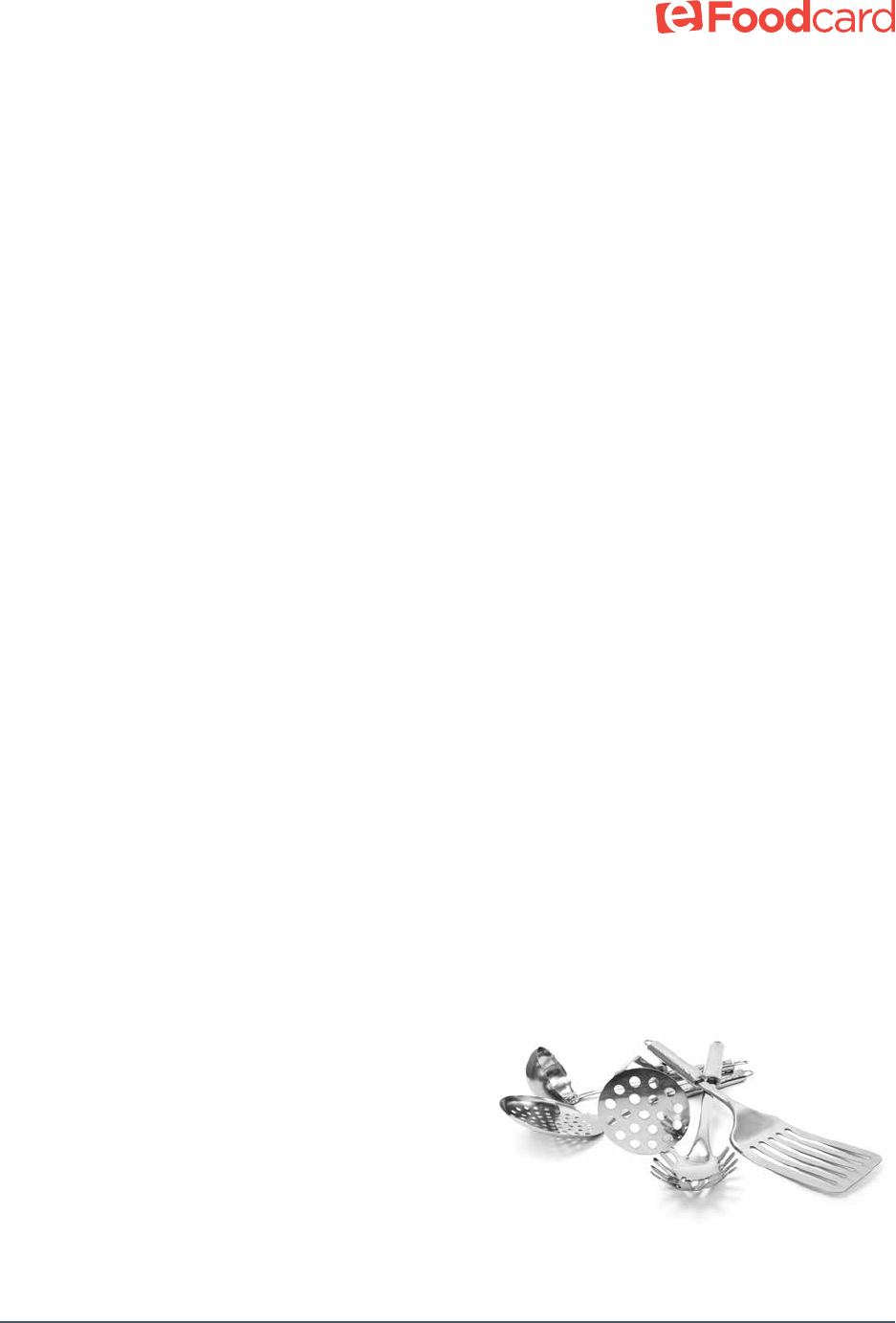
eFoodcard.com / Copyright © 2019 21
It takes more than soap and water to keep a food business clean and safe.
You will likely be using detergents and sanitizers.
Section 7.1 Follow These Important Rules
Know what the directions say for using chemicals. Read the labels and
talk to your manager about when to use them and how much to use.
Be sure you understand and follow the directions!
• Keep chemicals away from food and clean utensils. If chemicals must
be stored in the same room, be sure they are stored in their own area.
The area should be below food and utensils, so there is no chance of
chemicals splashing onto the food and utensils.
• Can you read the labels? Are they easy to see? If they are not,
ask your manager to re-label them so that everyone can read them.
• Keep all chemicals in the bottles or boxes they come in. If you put
them in a dierent container, label them clearly.
Section 7.2 Utensils, Surfaces and Equipment
Another way to prevent cross contamination is to be sure that utensils, work
surfaces and equipment are washed, rinsed, and sanitized between uses.
• Wash them in hot soapy water
• Rinse them in clean hot water
• Sanitize them with freshly prepared
sanitizer (1 to 2 teaspoons of bleach
per 1 gallon of water)
Chapter 7. A Clean Workplace
is Safer
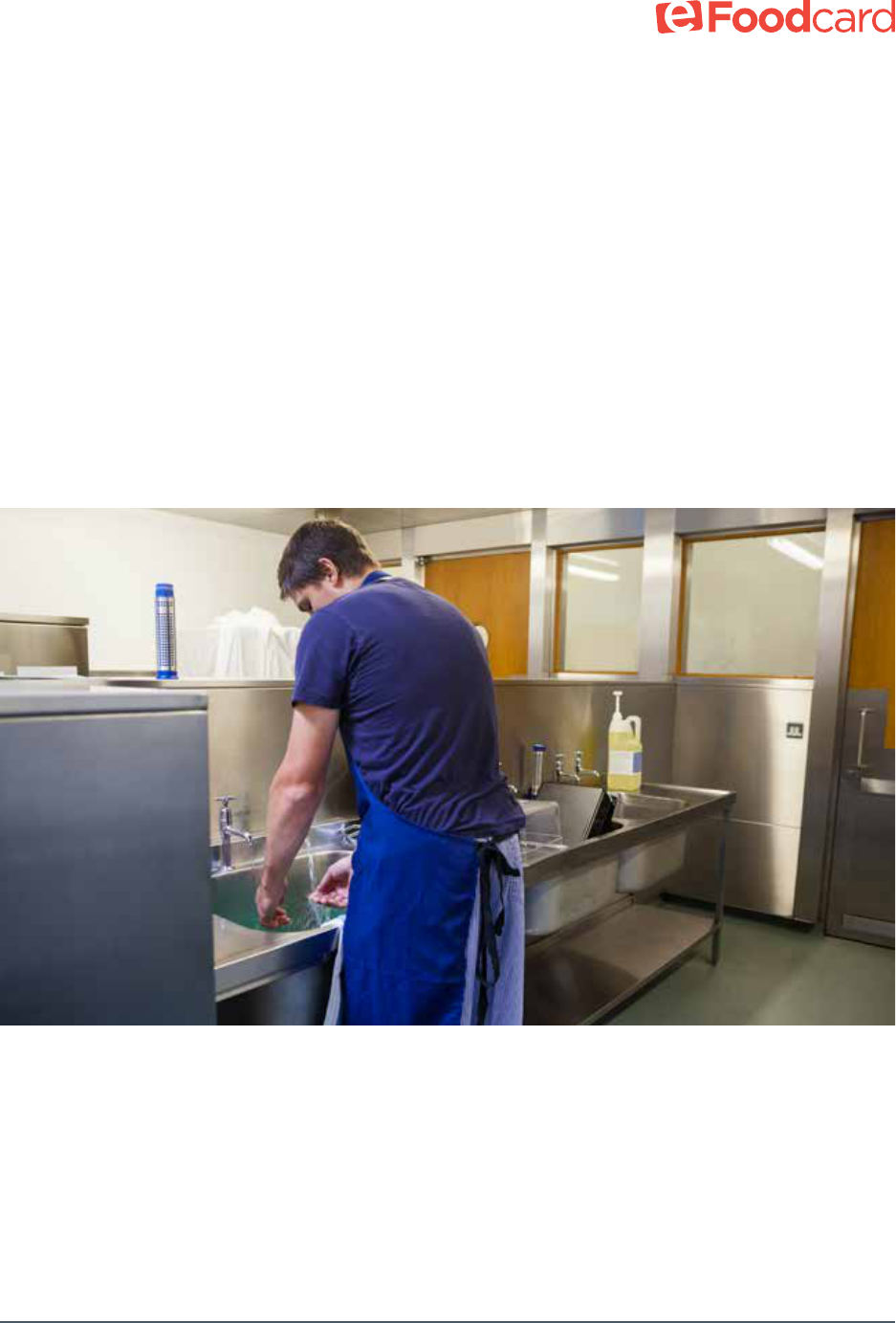
eFoodcard.com / Copyright © 2019 22
Section 7.3 Directions
Follow the cleaning directions for each piece of equipment.
Section 7.4 Remember
The correct steps for cleaning utensils, food contact surfaces and equipment are:
1. Wash
2. Rinse
3. Sanitize
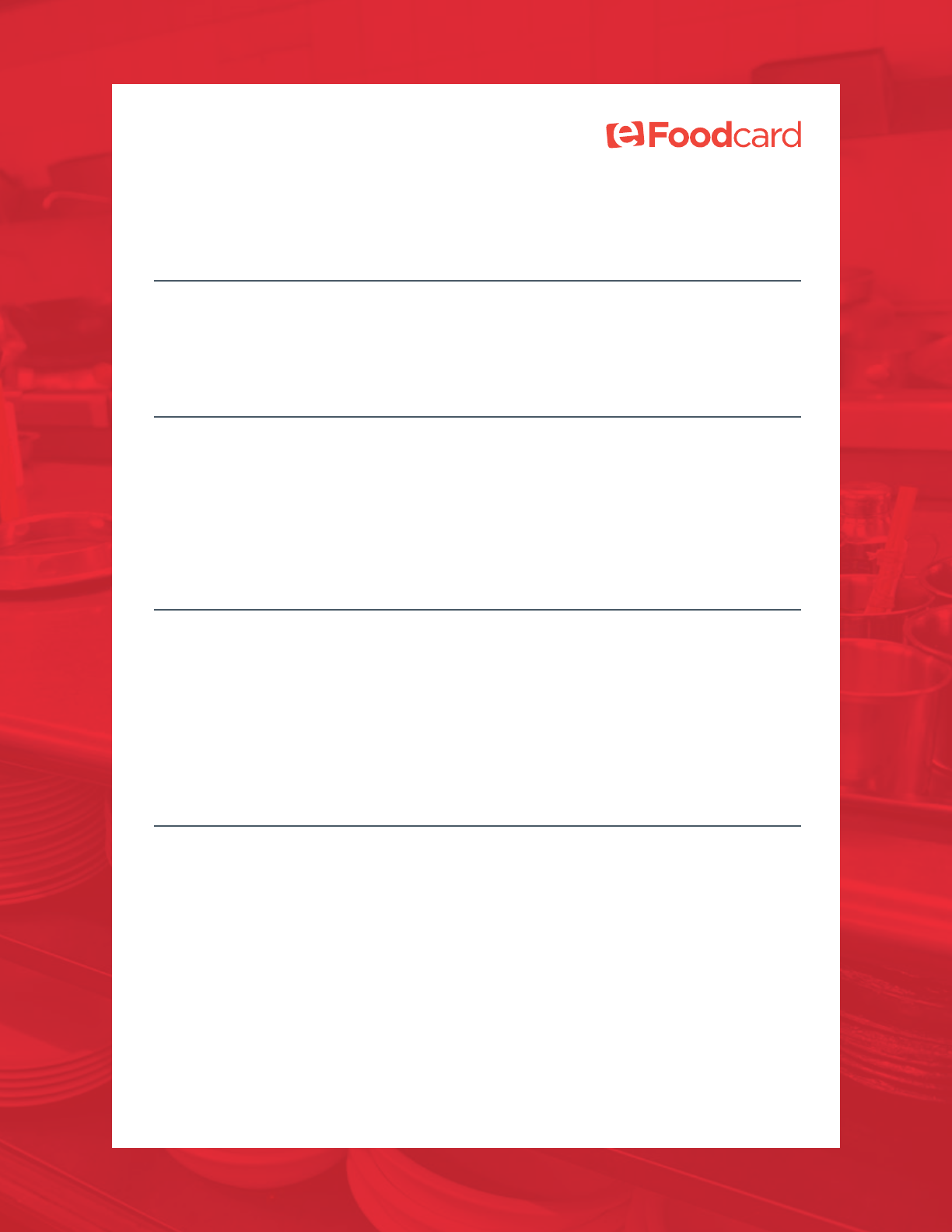
eFoodcard.com / Copyright © 2019 23
1. You should store chemicals separate and away from foods.
A. True
B. False
2. Where in the refrigerator should you store raw meat?
A. Above the vegetables
B. Next to the vegetables
C. With the vegetables
D. Below the vegetables
3. The most important reason to wash, rinse and sanitize a meat slicer
or knife is to:
A. Eliminate odors and tastes from getting into other foods
B. Prevent bacteria on one food from contaminating another food
C. Make the meat slicer or knife last longer and look better
D. Prevent garlic or other flavors from getting onto other foods
4. You found cooked rice left out on the counter all night, the safe way
to handle it is to:
A. Put the rice in the refrigerator
B. Throw the rice into the garbage
C. Take a temperature of the rice
D. Reheat the rice to 165°F (74°C)
Chapter 7 Review

eFoodcard.com / Copyright © 2019 24
Bacteria – Bacteria are germs with only
one cell that can multiply into large
numbers when food is in the danger
zone for more than 4 hours.
Bare Hand Contact Prohibition with
Ready-to-Eat Food – Bare hands
may not come into contact with food
that is ready to eat, such as salad or
sandwiches.
Chemicals – In this manual, chemicals
are referred to as ingredients in
cleaning, sanitizing, or pesticide
products that make people sick if eaten.
Cold Holding – Cold holding is
when you keep food cold by using
refrigeration or ice.
Cross Contamination – When germs
from one food item are passed to
another food item, usually raw food
to ready-to-eat food.
Danger Zone – The Danger Zone
is when the temperature of food is
between 41°F (5°C) and 135°F (57°C).
This is called the danger zone because
bacteria will grow quickly between
these temperatures.
Foodborne Illness – Sickness caused
from germs or toxins in food. This is
also called food poisoning.
Food Thermometer - A metal-stem
probe thermometer used to take
temperatures of food.
Hot holding – Holding food hot after it
has been properly cooked or reheated.
Food must maintain a temperature of
135°F (57°C) or hotter.
Infected – A cut or burn that is
swollen, red, or has pus.
Parasites – These are tiny worms
that live in fish, meat and humans.
Time/Temperature Control for
Safety/Potentially Hazardous Foods
– Moist, nutrient-rich foods that
supports the growth of bacteria when
the temperature is
between 41°F (5°C)
and 135°F (57°C).
Reheating for Hot Holding –
The process of making a cold food
hot before placing on warming unit.
Food must be heated from 41°F (5°C)
to 165°F (74°C) within two hours.
Sanitize –
The final step to removing
bacteria from food contact surfaces that
have just been cleaned. Many places use
a solution made up of one teaspoon of
bleach to one gallon of water to sanitize
equipment and utensils.
Virus – Viruses are germs that can only
reproduce inside of a living cell. It takes
a small number of viruses to make
someone sick. Many viruses get into
the food from the lack of hand-washing
especially after using the toilet and
then touching food.
Glossary
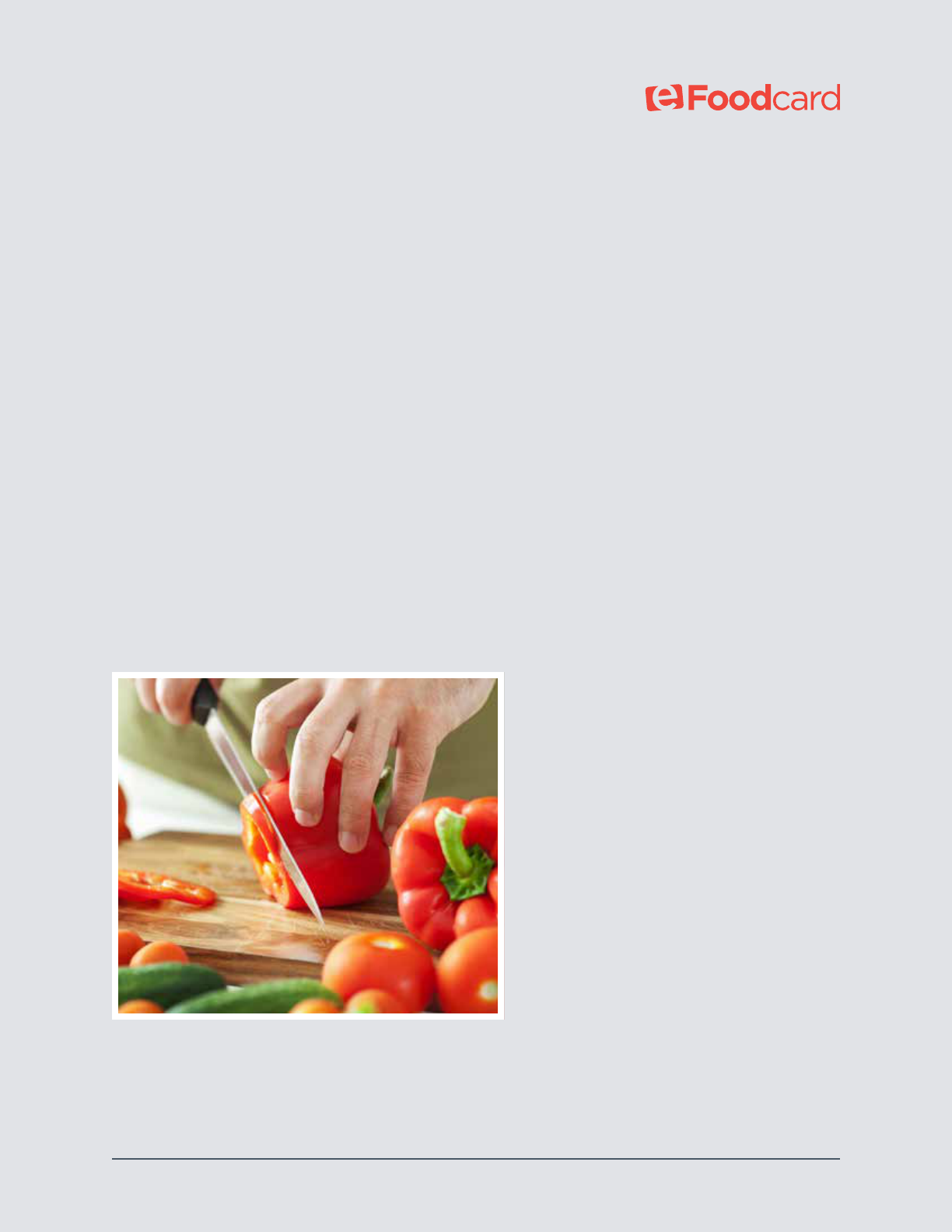
eFoodcard.com / Copyright © 2019 25
Reference
Food safety questions may come up that were not covered in the food
handler training section of this manual. This reference section provides
some additional food safety information.
General
Person In Charge (PIC)
The Food Sanitation Rules require that the licensee designate a person in
charge (PIC) during all hours of the operation. The PIC must know foodborne
Illness prevention and the requirements of the Food Sanitation Rules.
Every PIC must also know the policies and procedures within the food
establishment. If a PIC is not able to demonstrate knowledge, or is not onsite,
the facility will receive a critical violation during an inspection. Please refer
to chapter two of the Food Sanitation Rules to learn about the requirements
of the PIC.
Food Service Inspection Process
All establishments must follow
standard food-safety practices
critical to the safety and quality
of the food served. During
health department inspections,
the inspector compares the
Food Sanitation Rules to the
procedures at your establishment.
The PIC can solicit help from the
health department on how to
prepare for an ocial regulatory
inspection. The PIC can learn
to identify every food safety
problem, and how to correct it.

eFoodcard.com / Copyright © 2019 26
Employee Illness
Employee Illness
Infected food workers can spread a wide range of illnesses to others through
food and utensils. Employees sick with vomiting or diarrhea must not work
until symptoms have been gone for at least 24 hours.
Employees are required to report to the PIC when ill with any of the diseases
listed below, or they live in the same household as a person with one of these
diseases. An employee that has diarrhea, vomiting, jaundice, and sore throat
with fever must also report this information to the PIC. The PIC is required to
inform employees of this responsibility.
Most Common Illnesses from Employees
Common Symptoms
Foodborne Illnesses* D F V J S
1. Hepatitis A virus F J
2. Salmonella Typhi F
3. Shigella D F V
4. E. coli 0157:H7 D
5. Norwalk or Noro viruses D F V
6. Staphylococcus aureus D V
7. Streptococcus pyogenes F S
Key: D=Diarrhea, V=Vomiting, J=Jaundice, F=Fever, S=Sore throat with Fever
Note: *The PIC is required to notify the county health department when an
employee has Norovirus, Hepatitis A, Salmonella Typhi, Shigella or E. coli.
0157:H7

eFoodcard.com / Copyright © 2019 27
Hand-Washing
Keeping Hands Clean
Food employees with dirty hands and/or
dirty fingernails may contaminate the food
being prepared. Any activity that may have
contaminated the hands must be followed
by thorough hand-washing as described in
this manual (see pages 3 & 11).
Cleaning Procedure
Many employees fail to wash their hands as often as necessary and even
those who do may use a poor technique. It takes vigorous rubbing with soap
and running water for about 20 seconds to loosen soil and illness-causing
organisms (germs).
Many diseases transferred through food may be harbored in the employee’s
intestinal tract and shed in the feces. Proper hand-washing after a bowel movement
establishes a barrier against the transfer of organisms (germs) present in the feces.
Hand Sanitizers
Sanitizer dips or hand sanitizers are not approved handwash techniques and
are not acceptable substitutes to hand-washing.
Fingernails
The requirement for fingernails to be trimmed, filed, and maintained addresses
the ability to clean beneath the fingernails. Failure to remove fecal material
from beneath the fingernails after a bowel movement can be a major source of
illness causing organisms. Ragged fingernails may harbor harmful organisms.
Jewelry
Items of jewelry such as rings, bracelets, and watches may act as a hiding
place for foodborne illness causing organisms (germs). An additional hazard
associated with jewelry is the possibility that pieces of the item or the whole
item itself may fall into the food being prepared. Hard foreign objects in food
may cause medical problems for consumers, such as chipped and or broken
teeth and internal cuts and lesions.

eFoodcard.com / Copyright © 2019 28
Cooking Temperatures
Cooking Temperatures
Dierent raw animal foods have to reach dierent temperatures to be done
or safe. Use a metal-stem probe food thermometer to check temperatures
while cooking to make sure that it gets done all the way inside.
Why Use a Food Thermometer?
A metal-stem probe food thermometer is the only reliable way to know that
the temperature of food is hot enough to kill harmful
bacteria
. It also helps
you to avoid overcooking. Each kitchen must have at least one accurate
food thermometer that has a small enough probe to fit into thin food such
as a thin meat patty.
Cooking Requirements for Specific Foods
The next page shows the temperature that specific foods must reach
be to be safe.

eFoodcard.com / Copyright © 2019 29
Cooking Requirements for Specific Foods
Animal Product Minimum Temperature What to Know?
Poultry, ground poultry 165°F (74°C) for 15 seconds Stung should be cooked
outside of poultry.
Stung, stued meats,
casseroles and dishes
combining raw and
cooked food
165°F (74°C) for 15 seconds Stung acts as an insulator,
preventing heat from reaching
the meat’s center. Stung
should be cooked separately.
Ground or flaked meats
hamburger, ground pork,
flaked fish, ground game
animals, sausage, injected
and pinned meats
155°F (68°C) for 15 seconds Grinding meat mixes the
organisms from the surface
into the meat.
Alternative minimum
internal temperatures
for ground meats:
150°F (66°C) for 1 minute
145°F (63°C) for 3 minutes
Pork, beef steaks, veal lamb,
commercially raised game
animals
145°F (63°C) for 15 seconds
This temperature is high enough
to destroy Trichinella larvae that
may have infested pork.
Beef or pork roasts 145°F (63°C) for 3 minutes Alternative minimum internal
cooking temperatures for beef
and pork roasts:
130°F (54°C) for 121 minutes
134°F (57°C) for 47 minutes
138°F (59°C) for 19 minutes
140°F (60°C) for 12 minutes
142°F (61°C) for 8 minutes
144°F (62°C) for 5 minutes
Fish, foods containing fish,
and seafood
145°F (63°C) for 15 seconds Stued fish should be cooked
to 165°F (74°C) for 15 seconds
Fish that has been ground,
chopped, or minced should
be cooked to 155°F (68°C)
for 15 seconds
Shell eggs for immediate
service
145°F (63°C) for 15 seconds Only take out as many eggs
as you need. Never stack egg
flats near the grill or stove.
Eggs cooked for later service
must be cooked to 155°F for
15 seconds and held at 135°F.
Foods cooked in microwave -
meat, poultry, fish, eggs
165°F (74°C) let it stand for
2 minutes after cooking
Cover food, rotate or stir it
halfway through the cooking
process.
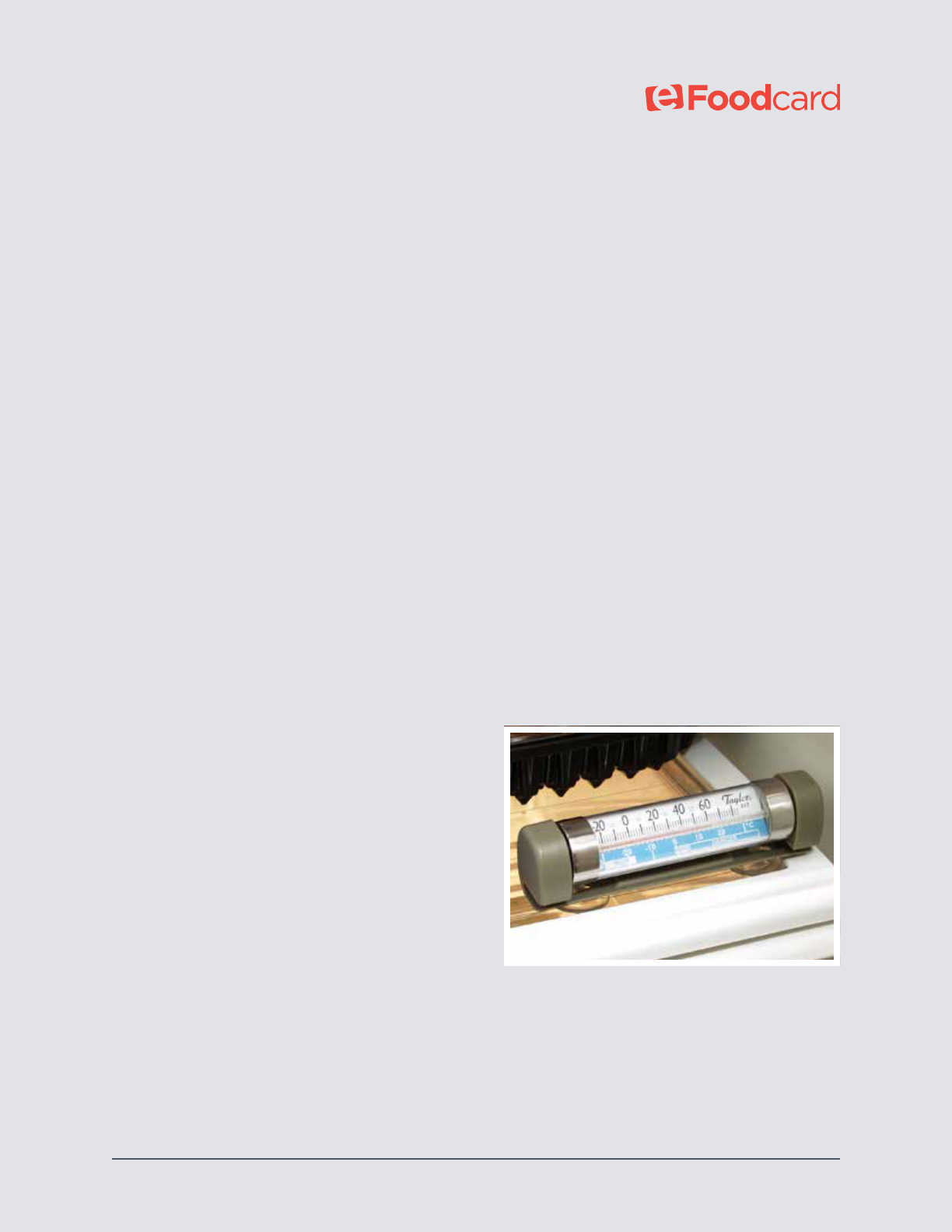
eFoodcard.com / Copyright © 2019 30
“Is It Done Yet?”
How to Use a Food Thermometer
• A thermometer that works best has a range of 0°F (-18°C) to
220°F (104°C).
• Use a thermometer with a smaller diameter probe on thin foods such
as thin hamburger patties.
• Check the internal temperature of the food toward the end of the
cooking time.
• Place the thermometer in the thickest part of the meat or in the center
of the food to get a true reading. (Do not touch the bone with the stem
of the thermometer to prevent a false reading).
• When taking temperatures of a large amount of food like a big piece of
meat, be sure to take the temperature in two or more locations.
• Compare your thermometer reading to the Required Cooking Temperatures
on the previous page to determine if your food has reached a safe
temperature.
• Wash and sanitize the thermometer each time you check the temperature
of a food.
Refrigerator Thermometer
Every refrigerator is required to have a
thermometer. This thermometer must
be located where it is easy to see when
you open the refrigerator door. Every
refrigerator should be operating at 41°F
or less as indicated by the thermometer.
If the thermometer reads above 41°F,
then use a metal-stem probe food
thermometer to check the temperature
of food inside of the refrigerator with a
food thermometer.

eFoodcard.com / Copyright © 2019 31
Types of Food Thermometers
Name Speed Placement
Thermocouple
(Most models can be calibrated)
2-5 seconds
1/4” or deeper
in the food as
needed
Thermistor
(Some models can be calibrated)
10 seconds
At least 1/2” deep
in the food
Instant-Read Bimetal (Most models can be calibrated)
15-20 seconds 2- 2 1/2” deep
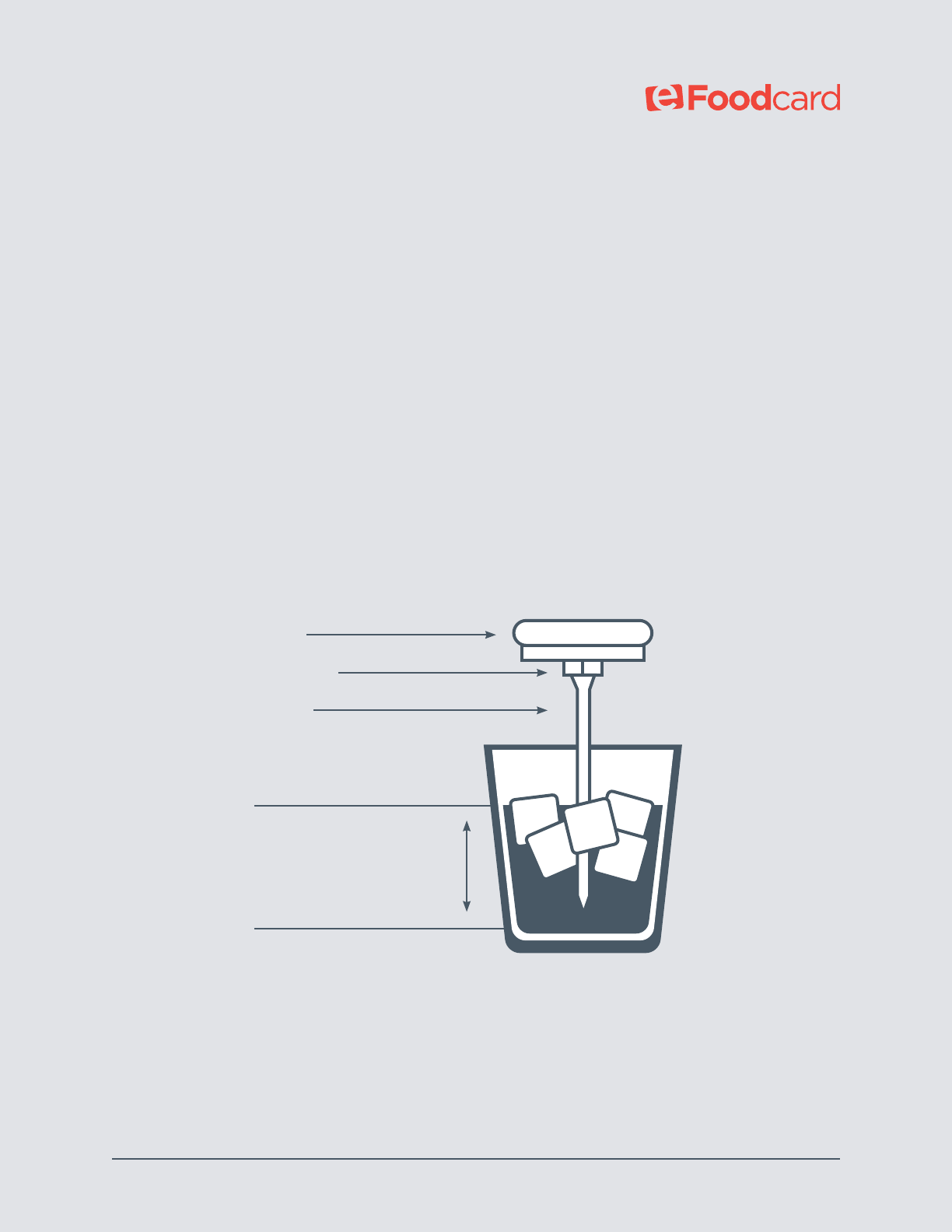
eFoodcard.com / Copyright © 2019 32
Calibrating a Dial Food Thermometer
When you use a dial food thermometer you need to make sure the
temperature it gives you is accurate. An easy way to do this is to use ice and
water.
Pack a large cup to the top with crushed ice and water. Put the thermometer
at least 2 inches into the ice slurry. After 30 seconds, read the dial. It should
read 32°F (0°C). If it does not, you need to:
1. Leave it in the ice slurry. Add ice as it melts.
2. Use pliers or a wrench and turn the nut on the back of the thermometer
until the needle reads 32°F (0°C).
3. Wait 30 seconds. Keep repeating these steps until the thermometer
reads 32°F (0°C).
Head
Hex nut
Stem
Ice water (32°F, 0°C)
2” (5cm) minimum
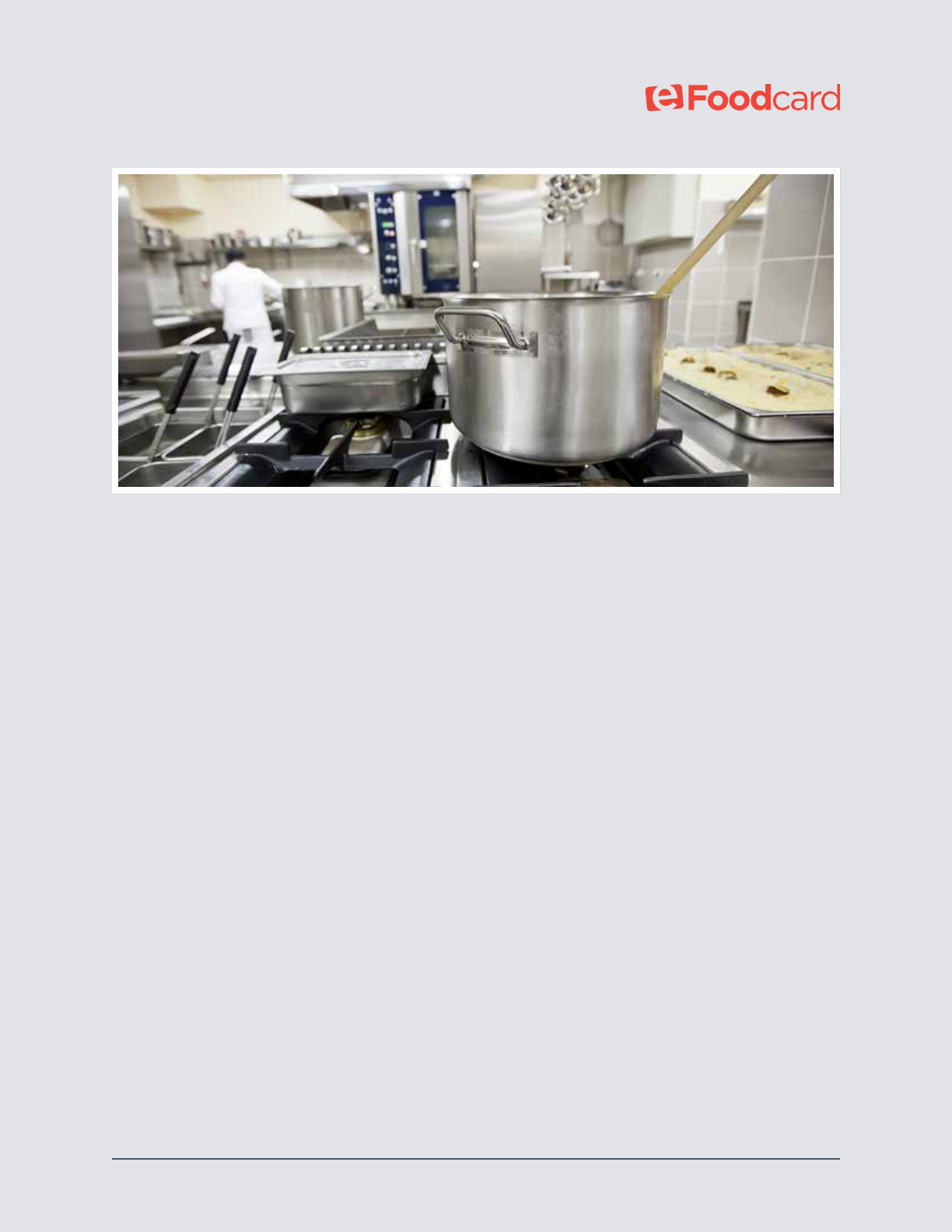
eFoodcard.com / Copyright © 2019 33
Cooling Hot Foods
With cooling of foods it is important to move the food temperature through
the “Danger Zone” as quickly as possible to keep food safe.
Fresh is Best
You always take a chance that
bacteria
can grow and produce toxins
when you cool food. It is safest to make food fresh each day, just before
you serve it.
Speed is Important with Cooling
If you must make food in advance or save leftover food, cool it as fast as you
can to prevent
bacteria
growth and toxin production. Reheating will not
destroy toxins.
Cooling Solid Foods
When cooling solid cooked foods such as roast, turkey, and solid cuts of
meat, be sure to:
1. Cut large roasts and turkeys into smaller portions. This will help them
to cool faster.
2. Put all meats and other hot food in the refrigerator uncovered.

eFoodcard.com / Copyright © 2019 34
Cooling Soft/Thick Foods
Examples of soft/thick foods are refried beans, rice, potatoes, stews, chili,
thick soup or thick sauces.
You can cool soft/thick foods by pouring food into a shallow metal pan.
Use a sheet pan for very thick foods like refried beans.
Cooling thick food is not easy. Whenever possible, use a flat sheet pan
and spread the food out as shallow as you can to speed up the cooling.
When cooling food in shallow metal pans, be sure to:
1. Pour hot food into shallow metal pans. The shallower the pan the
faster the food will cool.
2. Stirring food speeds up cooling time.
3. Once food cools to 41°F (5°C), you can place food in a larger container
and cover it.
Air Movement
Air in the refrigerator must be able to move around the food. The pans and
dishes need to have space between them; do not crowd them. Do not stack
pans on each other. Do not cover the food while it is cooling. A cover may be
put on after the food has fully cooled.
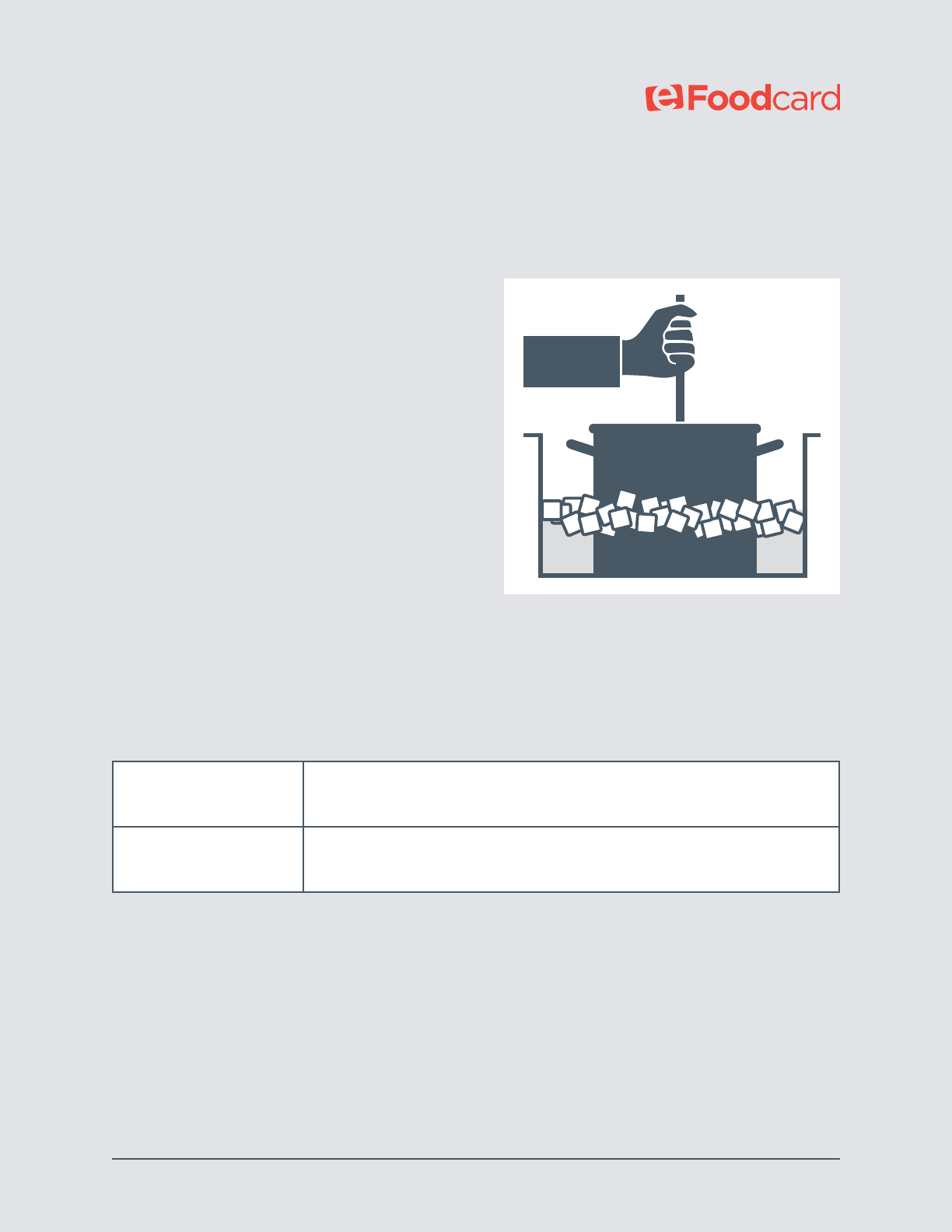
eFoodcard.com / Copyright © 2019 35
Cooling Liquid Foods
You can use shallow metal pans or you can use the ice and water bath to
cool thin soup and sauces. When cooling food with an ice bath, be sure to:
1. Close the drain in a large sink.
Place the metal pot or pan of hot
food in the sink. The sink drain must
be indirectly plumbed.
2. Fill the sink with ice and cold water
up to the level of food in the pot
or pan.
3. Stir the soup or sauce often so that it
cools all the way to the center.
Ice paddles or cooling wands can be
used to speed up the cooling process.
4. Add more ice as ice melts.
5. The food must reach 41°F (5°C).
Remember
You can choose several ways to cool food. No matter how you cool the food,
it must drop from:
2 Hours
135°F (57°C) to 70°F (21°C) within two hours
and then the temperature must drop from
4 Hours 70°F (21°C) to 41°F (5°C) within four hours.
Use a food thermometer to check the temperature while it is cooling. If it isn’t
cooling fast enough, you will need to do something else to speed up cooling.

eFoodcard.com / Copyright © 2019 36
Date Marking
Ready-to-eat Time/Temperature Control for safety/potentially hazardous
foods must be date marked with either the preparation date, use-by date, or
date the commercial package was opened.
Seven Days
The food can be stored for seven days when the refrigerator maintains
41°F (5°C) or colder. Food older than seven days must be discarded.
One Day
Food used within one day is not required to be date marked.
Pests
Cockroaches, flies, mice and rats can carry disease and cause damage.
Prevention and control of these pests is essential.
Keep the inside and outside areas clean. Outside garbage must be
contained in watertight containers with lids remaining closed when not
in use. Exclude flies, especially during the warmer months, by screening
open doors and windows screened with 1/16th of an inch mesh.
Pests can come into the facility through small holes or gaps under the door
to the outside. A mouse can slip through a space of 1/4 inch. Block their entry
by eliminating small holes and gaps under and around the door.
If you find pests inside your facility, contact a licensed pest control service.
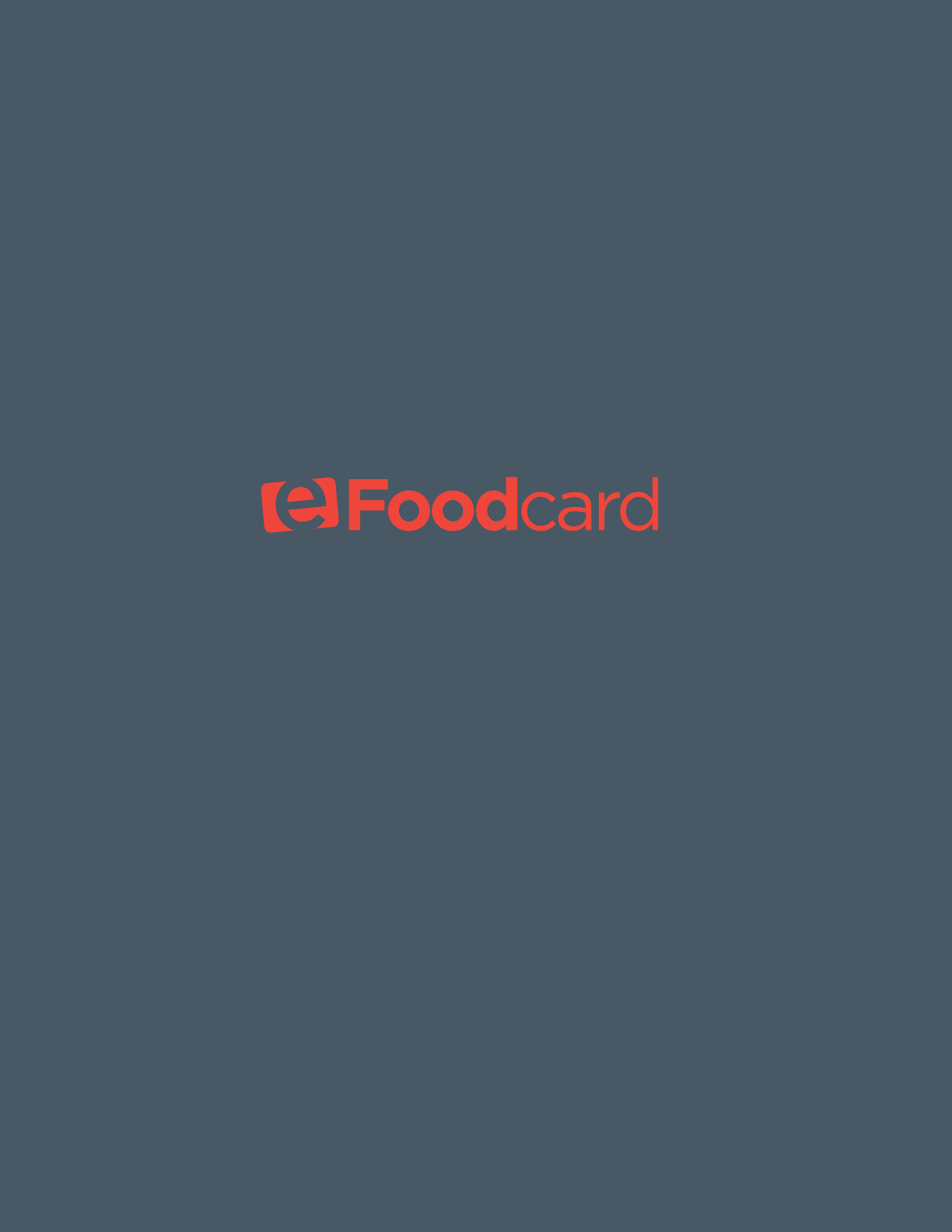
Food Industry Training
Acknowledgements
Our Thanks to the California and Oregon Health Authorities,
Oce of Environmental Public Health Foodborne Illness
Prevention Program for these materials. The eFoodcard Certificate
Program is FDA 2017 Code Compliant.
